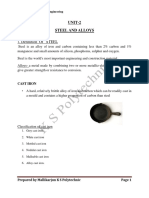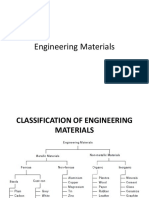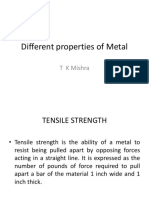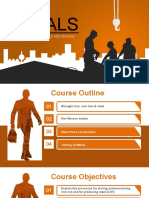0 ratings0% found this document useful (0 votes)
7 viewsCharacteristics of Copper
Characteristics of Copper
Uploaded by
Balaji ShreyanThe document discusses the characteristics, physical properties, development of alloys, and classification of copper and its alloys. It describes the properties and applications of unalloyed copper, brasses, and typical applications of brasses.
Copyright:
© All Rights Reserved
Available Formats
Download as PPTX, PDF, TXT or read online from Scribd
Characteristics of Copper
Characteristics of Copper
Uploaded by
Balaji Shreyan0 ratings0% found this document useful (0 votes)
7 views9 pagesThe document discusses the characteristics, physical properties, development of alloys, and classification of copper and its alloys. It describes the properties and applications of unalloyed copper, brasses, and typical applications of brasses.
Original Title
CHARACTERISTICS OF COPPER
Copyright
© © All Rights Reserved
Available Formats
PPTX, PDF, TXT or read online from Scribd
Share this document
Did you find this document useful?
Is this content inappropriate?
The document discusses the characteristics, physical properties, development of alloys, and classification of copper and its alloys. It describes the properties and applications of unalloyed copper, brasses, and typical applications of brasses.
Copyright:
© All Rights Reserved
Available Formats
Download as PPTX, PDF, TXT or read online from Scribd
Download as pptx, pdf, or txt
0 ratings0% found this document useful (0 votes)
7 views9 pagesCharacteristics of Copper
Characteristics of Copper
Uploaded by
Balaji ShreyanThe document discusses the characteristics, physical properties, development of alloys, and classification of copper and its alloys. It describes the properties and applications of unalloyed copper, brasses, and typical applications of brasses.
Copyright:
© All Rights Reserved
Available Formats
Download as PPTX, PDF, TXT or read online from Scribd
Download as pptx, pdf, or txt
You are on page 1of 9
CHARACTERISTICS OF COPPER
• High electrical conductivity
• High thermal conductivity
• High corrosion resistance
• Good ductility and malleability
• Reasonable tensile strength
• Non-toxic
PHYSICAL PROPERTIES OF COPPER
Crystal structure : FCC
Atomic number : 29
Atomic weight : 63.5
Density (g/cm3) : 8.9
Melting point (⁰C) : 1084.6
DEVELOPMENT OF DIFFERENT COPPER ALLOYS
CLASSIFICATION OF COPPER ALLOYS
According to the chemical composition:
• Unalloyed copper
• Brasses (Cu-Zn + other alloying elements)
• Bronzes (Cu + Sn + other elements except Zn)
• Cupronickel (Cu-Ni) alloys
According to the applications:
• Cast alloys
• Wrought alloys
UNALLOYED COPPER
Characteristics:
• Good electrical, thermal conductivities
• High corrosion resistance
• Easily fabricated
• Reasonable tensile strength
• Controllable annealing properties
• Good soldering and joining properties
TYPICAL APPLICATIONS OF UNALLOYED COPPER
copper finish copper trolly
parts wires
Copper heat sink electronics products
BRASSES (Cu-Zn + other alloying elements)
• Brass is an alloy primarily made of copper and zinc
• Although copper and zinc form the basis of any brass, aluminium, lead
and arsenic are often used as alloying agents to improve machinability
and corrosion resistance.
• Brass alloys can be made using a variety of compositions in order to
meet the exact demands of a given applications.
Typical applications
• Decorative items for its bright gold like appearance
• Applications where low friction is required such as locks, gears,
bearings, doorknobs, ammunition casing and valves.
• Plumbing and electrical applications.
• Musical instruments such as horns and bells for its acoustic
properties.
Typical applications of brass
brass sampling cock
Decorative lamp brass boat propeller
stand
You might also like
- Mse Notes - Unit - 2Document12 pagesMse Notes - Unit - 2337-ME- KIRTHAN DEVADIGANo ratings yet
- Komba 3Document54 pagesKomba 3juniorjrjohansen10No ratings yet
- Metals: Acabo, Galeon, Ong Estrada, Igdon, JuanicoDocument88 pagesMetals: Acabo, Galeon, Ong Estrada, Igdon, JuanicoNaidra AbarquezNo ratings yet
- Non Ferrous Metals and Alloys CH5 DDUDocument97 pagesNon Ferrous Metals and Alloys CH5 DDUPratik Thaker100% (1)
- 08 (B) Non-Ferrous MetalsDocument97 pages08 (B) Non-Ferrous Metalscasiobj91No ratings yet
- Engineering MaterialsDocument18 pagesEngineering MaterialsAhmed ElkomyNo ratings yet
- Presentation On: Non-Ferrous MetalsDocument56 pagesPresentation On: Non-Ferrous MetalsMohd AnasNo ratings yet
- Brass PPTDocument41 pagesBrass PPTAbhiram shuklaNo ratings yet
- Copper & Its AlloysDocument19 pagesCopper & Its AlloysSachinSahuNo ratings yet
- Copper and Its Alloys PresentationDocument50 pagesCopper and Its Alloys PresentationIranthaShalindaJayawardanaNo ratings yet
- Bt1 MetalsDocument21 pagesBt1 MetalsJeric LaureanoNo ratings yet
- Non Ferrous MetalsDocument37 pagesNon Ferrous MetalsumairNo ratings yet
- FERROUS & NON FERROUS MaterialDocument78 pagesFERROUS & NON FERROUS MaterialAnindita YustinandaNo ratings yet
- Aluminium, Copper and Its AlloysDocument14 pagesAluminium, Copper and Its AlloysManiesh LokapurNo ratings yet
- Non-Ferrous MetalsDocument24 pagesNon-Ferrous MetalsAbdullah Al Bari TusharNo ratings yet
- Metals ConstructionDocument20 pagesMetals ConstructionAkankshaNo ratings yet
- Metals ConstructionDocument20 pagesMetals ConstructionAkankshaNo ratings yet
- AMBC Lecture 2Document25 pagesAMBC Lecture 2aryansingh173173No ratings yet
- Report Sa Group 3 Sa Materials Science ECE 069Document17 pagesReport Sa Group 3 Sa Materials Science ECE 069James Laroda LaceaNo ratings yet
- Properties and Applications of MaterialsDocument65 pagesProperties and Applications of MaterialsSeashell BernzNo ratings yet
- Non-Ferrous Metals-1Document37 pagesNon-Ferrous Metals-1DANIEL WELDAYNo ratings yet
- 12-160415171250Document26 pages12-160415171250jeevan prasadNo ratings yet
- Metals: Dato, Dominic M. Esquillo, Mark Ryan L. Fabia, Bernardo M. Sison, Elijah G. Tan, Nicolas TDocument30 pagesMetals: Dato, Dominic M. Esquillo, Mark Ryan L. Fabia, Bernardo M. Sison, Elijah G. Tan, Nicolas TJOSEPH REFUERZONo ratings yet
- Unit-2 Part-5Document9 pagesUnit-2 Part-5Tisha MishraNo ratings yet
- Module 3 - Part2 - Non-Ferrous - 7-10-24Document30 pagesModule 3 - Part2 - Non-Ferrous - 7-10-24rasutar1245No ratings yet
- Non-Ferrous MetalDocument21 pagesNon-Ferrous MetalKArthik AustinNo ratings yet
- Ferrous and Non-Ferrous MetalsDocument34 pagesFerrous and Non-Ferrous MetalsballDISCOVERIES PHballDISCOVERIESNo ratings yet
- Non Ferrous Metals and Their AlloysDocument11 pagesNon Ferrous Metals and Their AlloysmohansaiNo ratings yet
- Properties of ASISI CodeDocument16 pagesProperties of ASISI CodeTribhuwan MishraNo ratings yet
- COPPERDocument22 pagesCOPPERPayallulla7No ratings yet
- Materials For Automobiles15Document25 pagesMaterials For Automobiles15Er. DevendraNo ratings yet
- Unit 5 W7 DJJ3213 (Metal Alloys)Document35 pagesUnit 5 W7 DJJ3213 (Metal Alloys)Syfull musicNo ratings yet
- Non Ferrous MaterialsDocument51 pagesNon Ferrous MaterialsDhana LakshmiNo ratings yet
- METAL ALLOY (Chapter 5)Document10 pagesMETAL ALLOY (Chapter 5)Muhd AriffNo ratings yet
- Metals 18-19Document35 pagesMetals 18-19ZACHARIE TUYUBAHENo ratings yet
- University Institute of Architecture Subject - Building Material and Contruction - V Subject Code - 311 Topic - Ferrous and Non - Ferrous MetalsDocument34 pagesUniversity Institute of Architecture Subject - Building Material and Contruction - V Subject Code - 311 Topic - Ferrous and Non - Ferrous MetalsSaksham SharmaNo ratings yet
- Mse Notes - Unit - 3Document11 pagesMse Notes - Unit - 3337-ME- KIRTHAN DEVADIGANo ratings yet
- Non Ferrous MetalsDocument36 pagesNon Ferrous MetalsktnatashaNo ratings yet
- Classification of Materials: Shivan I. Abdullah Mechanical Engineering Dept. September 2021Document29 pagesClassification of Materials: Shivan I. Abdullah Mechanical Engineering Dept. September 2021Esmail AnasNo ratings yet
- Construction Materials History of MetalsDocument59 pagesConstruction Materials History of MetalsPatrick BuanNo ratings yet
- Alloying Elements and Alloys (1) - 17471991 - 2023 - 05 - 31 - 18 - 57Document27 pagesAlloying Elements and Alloys (1) - 17471991 - 2023 - 05 - 31 - 18 - 57Anoop AnuNo ratings yet
- LECTURE # 12, Refractory Metals and AlloysDocument16 pagesLECTURE # 12, Refractory Metals and AlloysMalik Nazim ChannarNo ratings yet
- Lecture 4 Non Ferrous MetalsDocument46 pagesLecture 4 Non Ferrous MetalsBoitumelo MolupeNo ratings yet
- Chapter 7 SteelDocument44 pagesChapter 7 SteelDdeqz Elina Bueno INo ratings yet
- Nonferrousmetal 171110093912Document68 pagesNonferrousmetal 171110093912maarof.emadNo ratings yet
- COPPERDocument16 pagesCOPPERk lightNo ratings yet
- MetalDocument15 pagesMetalshivani kanaujiyaNo ratings yet
- Unit 6 Non Ferrous Metals - IntroductionDocument63 pagesUnit 6 Non Ferrous Metals - IntroductionMruganesh SonarNo ratings yet
- Nonferrous Metals and AlloysDocument28 pagesNonferrous Metals and AlloysJezzrel Xandy BalmesNo ratings yet
- 7 MetalsDocument66 pages7 MetalscolinxNo ratings yet
- Unit 7 Metal and AlloysDocument61 pagesUnit 7 Metal and AlloysJeewan KunwarNo ratings yet
- CHPT 11Document15 pagesCHPT 11ravi308No ratings yet
- Non-Ferrous-Metals-rev.Document20 pagesNon-Ferrous-Metals-rev.Joseph John RodriguezNo ratings yet
- Clase 1Document31 pagesClase 1Miguel Angel Rodriguez RamirezNo ratings yet
- Metal 141005071229 Conversion Gate01Document18 pagesMetal 141005071229 Conversion Gate01cuong304No ratings yet
- IME - Module 4Document33 pagesIME - Module 4omega006ffNo ratings yet
- Arch111 Lecture 3 SteelDocument76 pagesArch111 Lecture 3 SteelGameli Ayivi-TosuhNo ratings yet
- Steel: Stones Bricks Cement ConcreteDocument46 pagesSteel: Stones Bricks Cement ConcreteKaushik RNo ratings yet



























































